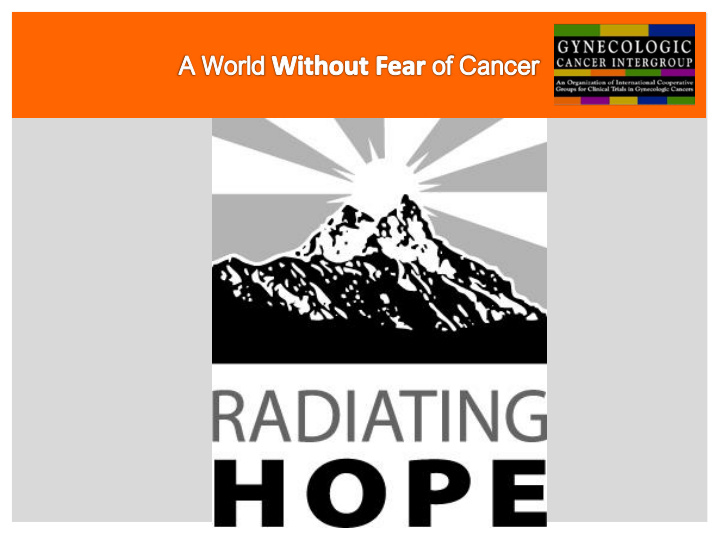



• Physician- • From Utah- USA • Radiation Oncology • Gamma West Cancer Service in Utah • Philanthropist • President – RadiatingHope • Member CCRN • Board of Directors - Above and Beyond Cancer • Mountain climber • Member of Search and Rescue • Rock and High Altitude climbing Cervix Cancer Education Symposium, February 2018
: • Global Oncology • Global Access to Radiation • Opportunities for global outreach within RadiatingHope FRESH HOPE? Cervix Cancer Education Symposium, February 2018
7 out of 10 cancer deaths globally occur in developing countries Cancer kills more people than HIV/AIDS, Malaria, and Tuberculosis combined Developing countries make up roughly 85% of the world ’ s population, and possess only one third of the world ’ s radiation equipment. Developing countries lack availability to radiation equipment and the equipment they do have is usually outdated and insufficient Cervix Cancer Education Symposium, February 2018
Cancers globally: • 15+ million in 2016 – 2/3 will occur in developing countries. • “ It is not an exaggeration to say that cancer represents an imminent crisis for developing countries. ” • IAEA Director General Yukiya Amano Cervix Cancer Education Symposium, February 2018 3. Ferlay J, Shin HR, Bray F, et al: Estimates of worldwide burden of cancer in 2008: GLOBOCAN 2008. Int J Cancer 127:2893-2917, 2010. 4. Farmer P, Frenk J, Knaul F, et al: Expansion of cancer care and control in countries of low and middle income: a call to action. Lancet 376:1186-1193, 2010.
quick facts: – 7 out of 10 cancer deaths globally occur in developing countries – Cancer kills more people than HIV/AIDS, Malaria, and Tuberculosis combined – Developing countries make up roughly 85% of the world ’ s population, and possess only one third of the world ’ s radiation equipment. – Developing countries lack availability to radiation equipment and the equipment they do have is usually outdated and insufficient Cervix Cancer Education Symposium, February 2018 1. Salminen E, Anacak Y, Laskar S, et al: Twinning partnerships through International Atomic Energy Agency (IAEA) to improve radiotherapy in common paediatric cancers in low- and mid-income countries. Radiother Oncol 93:368 – 371, 2009. 2. International Atomic Energy Agency: Design and implementation of a radiotherapy programme: Clinical, medical physics, radiation protection and safety aspects. [IAEA-TECDOC-1040.] Vienna, Austria, International Atomic Energy Agency,1998.
• US: • Approximately 1 machine for 100,000 people • 2% of machines are cobalt • Africa: • 1 machine for 4.8 million people • 48% of machines are cobalt • South America: • 1 machine for 640,000 people • 39% of machines are cobalt • Nepal: • 1 machine for 6 million people • 40% of machines are cobalt Cervix Cancer Education Symposium, February 2018
• Rwanda: – No machines • Uganda: – 1 machine per 33,000,000 • Tanzania: – 1 machine per 14,000,000 • Sudan: – 1 machine per 7,000,000 • Mali: No machines • Senegal: – 1 machine per 13,000,000 • Ghana: – 1 machine per 1,000,000 • Ethiopia: – 1 machine per 70,000,000 • South Africa: – 1 machine per 1,000,000 Overall: Megavoltage machines are in 23 of the 52 of the African countries International Atomic Energy Agency: DIRAC (Directory of Radiotherapy Centres). Updated February 2011. Available at: http://www-naweb.iaea.org/nahu/dirac/informationupdate.asp. Accessed July 21, 2011. Cervix Cancer Education Symposium, February 2018
Cervix Cancer Education Symposium, February 2018
Dr. Margaret Chan- Director-General of the WHO said: • “A complex group of diseases like cancer MUST be tackled partners!!” on fronts, by • Partners: • Country Initiatives • GlobalRT • RadiatingHope • Partners in Health • CCRN • ARRO/ASTRO • Above and Beyond Cancer • ICEC- International Cancer Expert Corps • Foundation for Cancer Care in Tanzania • So on and so on!!! Cervix Cancer Education Symposium, February 2018
• Radiotherapy is perceived as a complex treatment and has lead to a misleading assumption is that its deployment in poorer nations is not feasible, but • “ nothing could be further from the truth ” . • Radiotherapy can be effectively standardized and delivered irrespective political, and cultural context. Lancet provided evidence to show that radiotherapy is affordable and feasible, and can be safely and consistently delivered in low-income and middle-income countries. Cervix Cancer Education Symposium, February 2018
• Investment in radiotherapy: • Not only enables treatment of large numbers of cancer cases to save lives • They state that as we ‘scale - up’ the radiotherapy capacity in 2015– 35 from current levels could lead to saving of 26.9 million life-years in low-income and middle-income countries over the lifetime of the patients who received treatment. • But also brings positive economic benefits. • The economic benefits of investment in radiotherapy are very substantial.
Cervix Cancer Education Symposium, February 2018
Global Oncology Outreach Cancer treatments should be available to all, not just the global ‘elite’
Provide and update radiation equipment in developing countries and advance cancer care in those countries.
• RadiaitngHope • Africa/Latin America/Nepal Projects • Ghana, Senegal • Honduras, Guatemala, Chile • Nepal • RadHope Society • www.radiatinghope.org • Annual Cancer Symposium • Training • Site visits and outreach • Prayer Flag and Climbing Projects • Super-advocate projects • Climbing- platform for fundraising Cervix Cancer Education Symposium, February 2018
• Concluding statement: • Time to take Action! End the needless suffering. . . Cancer cer treatments atments should uld be ava vail ilable ble to all, not just the global ‘elite’ • Time to climb that Mountain!!! Cervix Cancer Education Symposium, February 2018
Gynecologic Cancer InterGroup Cervix Cancer Research Network • Time to take Action! • Time to climb that Mountain!!! Cervix Cancer Education Symposium, February 2018
Thank You Cervix Cancer Education Symposium, February 2018
Recommend
More recommend